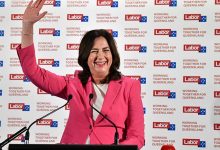Annastacia Palaszczuk’s re-election as Queensland Premier is set to see the state Labor government ramp up its investment in clean energy target after Queensland voters backed in the incumbent government for a third-straight term.
As of Monday morning, Queensland Labor looks to be on track to secure a strengthened majority in the state parliament, with a net gain of at least two additional seats, with Labor set to win at least 50 seats, more than the 47 needed for majority government.
The election results were characterised by a collapse in the vote for One Nation, which has shed around half of its vote compared to the 2017 state election, retaining its sole seat in the parliament, a strong result from the Greens, and the failure of the LNP to dislodge Labor in and around Townsville, where it prosecutes the case for coal power most vigorously.
The LNP will likely end up with five fewer seats compared to the prior election, despite a positive swing of around 2.1 per cent, prompting the resignation on Monday morning of Queensland LNP leader Deb Frecklington.
Katter’s Australia party – a strong supporter of the Copperstring transmission link between Townsville and Mt Isa, is on track to retain its three seats, with the Greens expected to double its presence with two seats.
The Palaszczuk government has committed to achieving a 50 per cent renewable energy target by 2030, which will require a significant ramp-up in new investment, over and above the major new contracts signed in the lead up to the poll. Recent analysis suggests that despite the current development pipeline and the pace of new wind and solar project additions, Queensland could still fall short of that milestone.
According to the OpenNEM platform, just under 15 per cent of electricity generated in Queensland was sourced from renewable energy sources, which had mostly been supplied by solar power, and in particular, rooftop solar installations.
Analysis from Green Energy Markets suggests that Queensland is currently on track to reach around 38 per cent renewable electricity generation by 2030, meaning accelerated investment will be needed to reach the government’s target.
In a move that will help spur this increased investment, the Palaszczuk government announced a $145 million plan in the lead up to the election to support the establishment of three new renewable energy ‘corridors’ across North Queensland, Central Queensland and South West Queensland.
The government hopes that the corridors, which will see new transmission network infrastructure investment coordinated with new investments in wind, solar and storage projects, could provide a combined long-term potential for 16,000 megawatts of new projects.
As part of its re-election pitch, Queensland Labor said that it would also invest $500 million through the government-owned corporations, including CleanCo, Energex, Ergon and Powerlink, to fast-track the development of the renewable energy corridors, and help the state reach the 50 per cent renewable energy target.
As reported in September, Queensland’s previous energy minister, Anthony Lynham, announced that he was to retire from parliament, and will not serve in the new term of the Palaszczuk government.
It is not yet clear who may take on the vacant energy portfolio, and it is understood that no decisions have been made as the final seats are yet to be decided as vote counting continues, along with a number of other vacancies across the Palaszczuk cabinet.
State development minister Kate Jones and communities minister Coralee O’Rourke also both opted to retire ahead of the state election, and former deputy premier and treasurer Jackie Trad looks set to lose her South Brisbane seat to a successful challenge from Greens candidate Amy MacMahon.
Whoever takes on the Queensland energy portfolio will be tasked with navigating a tricky balancing act that the Labor party has set for itself with regards to the future of coal and gas, with that of clean energy.
During the election campaign, Queensland Labor sought to balance demands from inner-Brisbane voters for stronger commitments for clean energy investments and emissions reduction targets, while also trying to shore up votes in regional Queensland by demonstrating its support for the state’s coal miners, including the recent approval of new mines.
The re-election of the Queensland Labor government follows similar successes for parties in the parliaments of the ACT and New Zealand, which saw incumbent labour-led governments rewarded for strong climate policies and Covid-19 responses with renewed terms.










